Hot News

- 出版單位:東吳大學社會系;輔仁大學社會系;世新大學社會心理學系
| 中文篇名 |
觀光享樂的背後:試析台灣社會的休閒及勞動關係 免費試閱 | |
|---|---|---|
| 英文篇名 |
Behind the Tourist Pleasure: A Study on the Relation of Leisure and Labor in Taiwan | |
| 作者 | ||
| 中文摘要 |
本研究探討「觀光享樂」現象背後的社會理論意義,使用2007年《台灣地區社會變遷基本調查計畫五期三次(休閒運動組)》的調查資料進行分析,檢證觀光行為、觀光慾望及工作狀態三者的關係,分為三個步驟進行:一、描述影響觀光的社會因素,指出年紀輕、高教育、收入高、有工作者傾向從事觀光行為;二、強調「工作」因素對於觀光行為及觀光慾望的特殊影響,指出全職工作者產生較強的觀光慾望;三、指出觀光所內含的「逃離日常生活」意義。綜合上述資料分析再以結構方程模式(SEM)確立理論模型,論證現代享樂式的觀光並不是「勞動」的對立面,而是「勞動/休閒」結構的一環。本研究從而提出理論性主張,認為觀光行為是工作與休閒結構所必需的社會內容,觀光動機亦是工作與休閒結構所必然的心理素質。 | |
| 英文摘要 |
This article explores the social significance behind the hedonistic tourist phenomenon, and proposes that the tour behaviors should be understood in terms of the capitalist labor/leisure structure. It is argued that the tour desire was created by the work. This article analyses the data of 2007 “General Social Survey in Taiwan” to inspect the relations among tour behavior, tour desire, and working status. Three steps of analysis were proceeded: (1) to describe the social factors affecting tourism, pointed out that young, highly educated, high-income, full-time worker have a tendency to engage in tour behavior; (2) to emphasize that “working status” factors has a special impact on the tour behavior and desire, ie, full-time work seems to incur more tour desire than others; (3) to point out the tourism has a sociological implication “to escape from everyday life”. At last, this article uses the SEM technique to certificate the theoretical model of the statistical data, and attempts to elaborate a theoretical argument that the modern hedonistic tourism is not the antithesis of the “labor,” but a part of the labor-leisure structure. | |
| 關鍵詞 |
工作、日常生活、本真性、休閒、觀光、work、everyday life、authenticity、leisure、tourism | |
| 刊名 | ||
| 期數 | ||
| 起訖頁 |
045-072 | |
| 出版單位 |
東吳大學社會系;輔仁大學社會系;世新大學社會心理學系 | |
| DOI | ||
| QRCode |
| |
| 上一篇 | ||
| 下一篇 |


